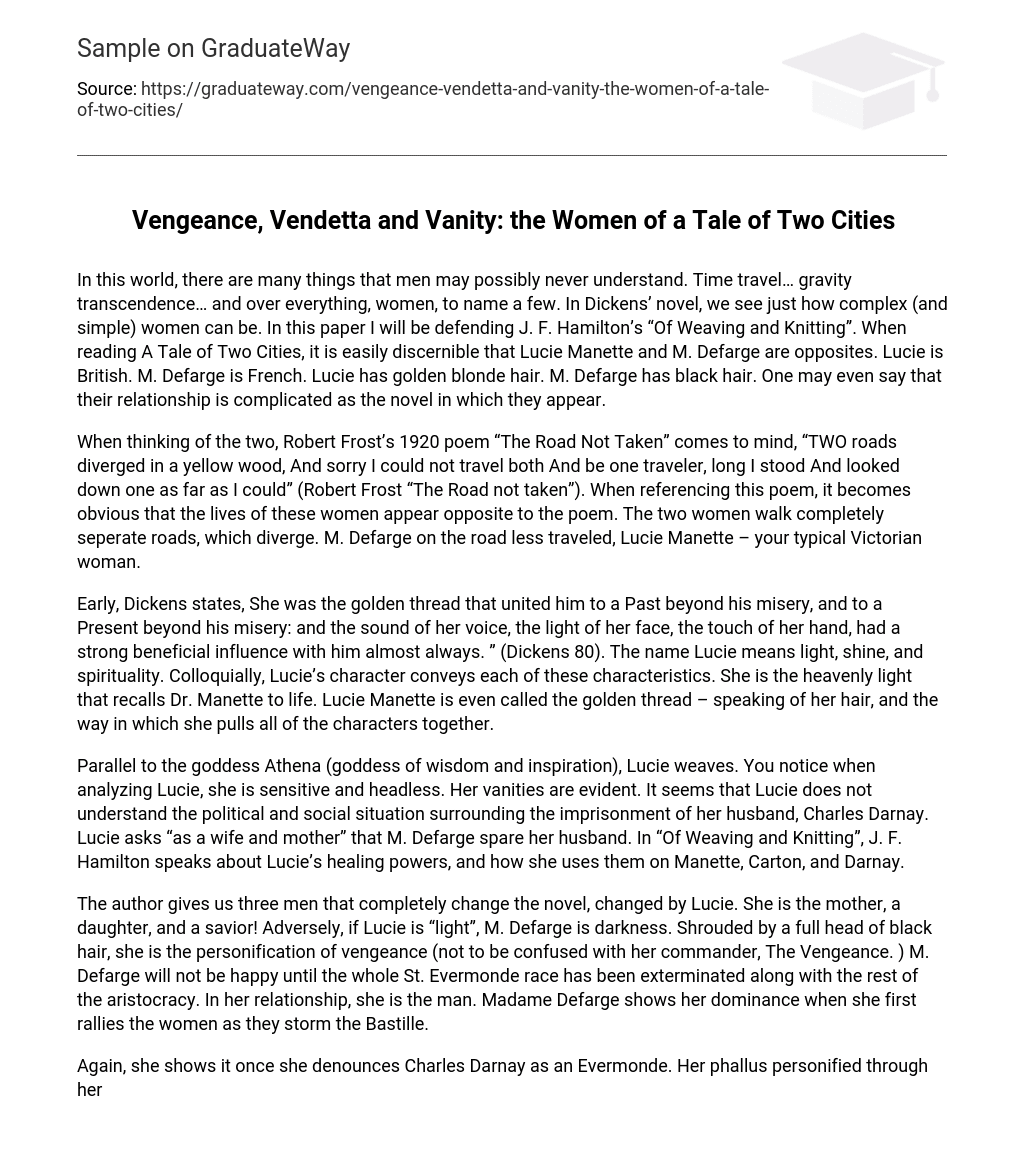In this world, there are many things that men may possibly never understand. Time travel… gravity transcendence… and over everything, women, to name a few. In Dickens’ novel, we see just how complex (and simple) women can be. In this paper I will be defending J. F. Hamilton’s “Of Weaving and Knitting”. When reading A Tale of Two Cities, it is easily discernible that Lucie Manette and M. Defarge are opposites. Lucie is British. M. Defarge is French. Lucie has golden blonde hair. M. Defarge has black hair. One may even say that their relationship is complicated as the novel in which they appear.
When thinking of the two, Robert Frost’s 1920 poem “The Road Not Taken” comes to mind, “TWO roads diverged in a yellow wood, And sorry I could not travel both And be one traveler, long I stood And looked down one as far as I could” (Robert Frost “The Road not taken”). When referencing this poem, it becomes obvious that the lives of these women appear opposite to the poem. The two women walk completely seperate roads, which diverge. M. Defarge on the road less traveled, Lucie Manette – your typical Victorian woman.
Early, Dickens states, She was the golden thread that united him to a Past beyond his misery, and to a Present beyond his misery: and the sound of her voice, the light of her face, the touch of her hand, had a strong beneficial influence with him almost always. ” (Dickens 80). The name Lucie means light, shine, and spirituality. Colloquially, Lucie’s character conveys each of these characteristics. She is the heavenly light that recalls Dr. Manette to life. Lucie Manette is even called the golden thread – speaking of her hair, and the way in which she pulls all of the characters together.
Parallel to the goddess Athena (goddess of wisdom and inspiration), Lucie weaves. You notice when analyzing Lucie, she is sensitive and headless. Her vanities are evident. It seems that Lucie does not understand the political and social situation surrounding the imprisonment of her husband, Charles Darnay. Lucie asks “as a wife and mother” that M. Defarge spare her husband. In “Of Weaving and Knitting”, J. F. Hamilton speaks about Lucie’s healing powers, and how she uses them on Manette, Carton, and Darnay.
The author gives us three men that completely change the novel, changed by Lucie. She is the mother, a daughter, and a savior! Adversely, if Lucie is “light”, M. Defarge is darkness. Shrouded by a full head of black hair, she is the personification of vengeance (not to be confused with her commander, The Vengeance. ) M. Defarge will not be happy until the whole St. Evermonde race has been exterminated along with the rest of the aristocracy. In her relationship, she is the man. Madame Defarge shows her dominance when she first rallies the women as they storm the Bastille.
Again, she shows it once she denounces Charles Darnay as an Evermonde. Her phallus personified through her knitting needle, she points it at Lucie and her daughter. Lucie, the picture of femininity is dominated by M. Defarge, the picture of masculinity. Madame Defarge tells her husband, “It is your weakness that you sometimes need to see your victim and your opportunity, to sustain you. Sustain yourself without that. When the time comes, let loose a tiger and a devil; but wait for the time with the tiger and the devil chained – not shown – yet always ready. ” Dickens 181).
She emasculates him. M. Defarge holds the power within the relationship. A proverb states, “Behind every great man, there is a woman. ” Behind Defarge (although far from great), there is his wife. Lucie’s goddess counterpart Athena alludes to that of Madame Defarge, Kali, an Indian goddess, referred to as “the bad mother”. For obvious reasons, M. Defarge has a vendetta against the Evermonde family – they killed her family. This, in part, justifies M. Defarge’s longing for retribution. A woman may be angry, but Defarge takes it too far. When Dr.
Manette comes to mind, you think of a fragile man who occasionally lapses into schizophrenia and cobbles. He was imprisoned by the Evermonde family for eighteen years. Yet, he does not want to kill Charles Darnay. Contrarily, Madame Defarge not only knits the name of Charles Darnay into her register, but also the names of his wife and child. She wants he and his family killed, which, (when compared to Dr. Manette) is completely ridiculous and maniacal. It’s important that we understand the dichotomy of Lucie Manette and Madame Defarge. Both are separate, complex (and in some cases, simple) creatures.
The most obviously identifiable similarity between the two is that they are women. Lucie, feminine, sensitive, and kind is in complete antithesis to the dark, masculine Madame Defarge. Lucie recalls men to life and Madame Defarge sentences them to death at “La Guillotine”.
Works Cited
Dickens, Charles. A Tale of Two Cities. New York: Bantam Books, 1981. Novel. Frost, Robert. Mountain Interval. New York: Henry Holt and Company, 1920. Book. Hamilton, J. F. “Of Weaving and Knitting. ” Explicator 53. 4 (1995):204. Academic Search Premier. Web. 14 Nov. 2011.





